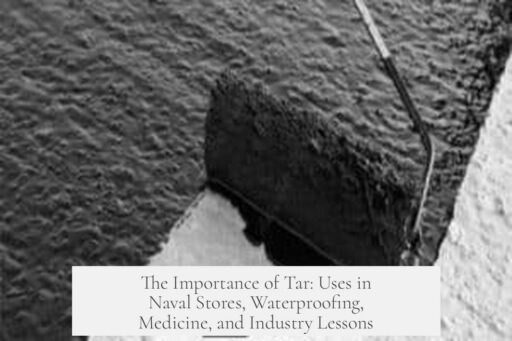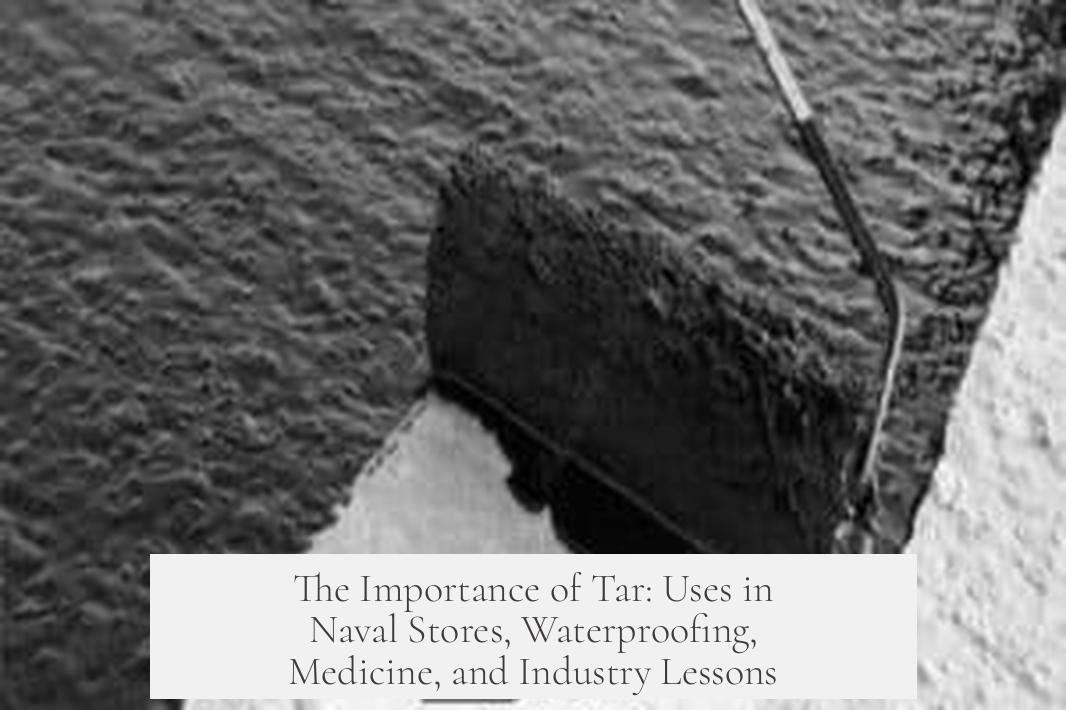Tar holds critical importance primarily due to its role in shipbuilding, where it serves key functions such as sealing, caulking, and waterproofing wooden vessels. Derived from plant resins, tar is a core product within the naval stores industry. This industry encompasses products extracted from plant resin that support ship maintenance, ensuring vessels remain water-resistant and durable.
Wooden ships, especially during the age of sail, required protection from water ingress. Tar was applied to seal gaps between wooden planks. This process often involved soaking rope in tar and wedging it tightly between boards to prevent leaks. Such use of tar helped ships withstand harsh marine conditions and extended their operational lifespans.
It is essential to distinguish this plant-derived tar used historically in shipbuilding from tar sourced from petroleum or peat. The plant-based tar provided coatings integral to traditional naval craft, reinforcing its role in maritime industries.
Economically, tar contributed significantly to regional revenue streams. Areas with access to tar pits or natural reserves prospered by producing and exporting tar alongside other naval stores. The Baltic region and parts of the Americas emerged as major exporters during the age of sail, fueling their economies through trade in tar and related materials.
- Tar acts as a sealant to waterproof wooden ships.
- Naval stores are products derived from plant resin, with tar as a primary component.
- Tar-soaked ropes were used to caulk seams between wooden planks.
- Plant-based tar differs from petroleum or peat-derived tar.
- Tar was a significant economic resource, enabling export-driven growth in regions like the Baltic and Americas.
Why Was Tar So Important, and What Was It Used For?

Tar’s importance lies deeply rooted in its crucial role in shipbuilding and maritime industries. But let’s not stop there; tar’s uses go far beyond slathering onto ships’ hulls. From sealing wooden vessels to generating income for entire regions, tar has been a hidden hero of commerce, craftsmanship, and even medicine. Curious how a sticky black substance could have such a vast significance? Let’s dive into the sticky details.
Imagine the age of sail: towering wooden ships braving wild seas, their survival hinging on the integrity of their hulls. Here, tar plays the unsung hero, transforming vulnerable wood into a water-resistant fortress. But this isn’t the gooey black stuff derived from oil spills. No, historically, tar meant something far more natural and plant-based.
Tar as the Backbone of Naval Stores
When we talk about tar in the context of shipbuilding, we’re actually discussing an entire industry called “naval stores.” This industry includes products derived mainly from plant resin—think pine trees and other conifers. These resins get processed into tar, pitch, and turpentine, all invaluable for maintaining naval vessels.
Why the fuss over tar? Because it was the go-to substance for sealing, caulking, and waterproofing wooden ships. As wooden planks met wooden keels, tiny gaps threatened catastrophic leaks. Scrappy sailors packed tar-soaked rope between planks to staunch water, creating a flexible yet watertight seal. This early “sealant technology” kept cargo dry and crew safe.
Tar: The Original Waterproofing Wonder
Consider this: before modern synthetic coatings, tar took the spotlight as a natural, durable water barrier. Its sticky, resinous nature means it clings tightly and flexes with the wood. This prevents cracks from allowing the salty ocean to sneak in.
Beyond ship hulls, tar spread its utility to other wooden constructions exposed to elements—bridges, roofs, and barrels often benefited from its protective embrace. The term “tarred and feathered” actually relates to these sticky properties, but that’s a story for another day!
Economics of Tar: Not Just a Side Hustle
Ever wondered how certain regions thrived economically during the age of sail? Access to tar pits and naval stores turned out to be a goldmine. The Baltic region and parts of the Americas exported massive quantities of naval stores, creating booming trade routes and renewable income.
Because tar doesn’t magically pop up on shelves but requires laborious extraction and processing, those controlling the supply held significant economic power. Sailing nations with access to these treasures could outfit their fleets without depending on foreign suppliers, strengthening naval dominance and trading advantages.
Tar’s Surprise Role in Medicine

Hold on—tar wasn’t just about ships and money. Ancient medical texts mention tar as a sealant for wounds. Imagine a battlefield scenario where quick sealing of cuts could save lives and prevent infections. Its antiseptic and waterproof qualities helped protect injuries in times long before modern bandages.
Unfortunately, detailed sources on this use are elusive, but the references point to tar’s sticky, protective nature lending itself well to temporary wound dressings.
A Unique Angle: Tar’s Natural Origins and Varieties
It’s essential to clarify something frequently muddled: the tar used historically in naval stores is plant-derived. This means it’s primarily extracted from pine resin and other natural sources. It should not be confused with tar derived from petroleum or peat, which has quite different chemical properties and uses.
This distinction matters because plant-based tar is biodegradable and environmentally friendlier compared to its fossil-fuel counterpart. That also explains its major role in the era before industrial petrochemicals became widespread.
What Can Modern Industries Learn From Tar?
In today’s world, synthetic waterproofing materials often overshadow traditional substances like tar. But tar’s long-lasting, flexible sealing properties indicate potential lessons for sustainable, more natural maritime maintenance practices.
Moreover, regions with tar resources once held strategic and economic leverage. This historical perspective sheds light on resource dependency and globalization patterns spanning centuries.
Practical Tips for Appreciating Tar’s Role
- Visit maritime museums: See traditional shipbuilding techniques using tar firsthand.
- Explore historical trade routes: Learn how tar exports shaped regional economies.
- Try natural DIY sealants: Basic tar-based products might still be viable for small wooden crafts.
Could tar’s natural defenses inspire new green technologies? Why not! Nature has been perfecting it for centuries.
In Conclusion
Tar offers a fascinating glimpse into human ingenuity. Its significance in shipbuilding, waterproofing, economy, and wellness touches multiple facets of history and technology. From sealing the seams of wooden ships to fueling the wealth of entire regions, tar has been much more than a sticky nuisance.
The next time you hear “tar,” think beyond the sticky mess. Remember that this ancient, plant-based sealant was a high-tech innovation of its day, preventing leaks, powering economies, and even tending wounds. It’s a timeless testament to how natural materials have shaped human progress in often overlooked ways.




